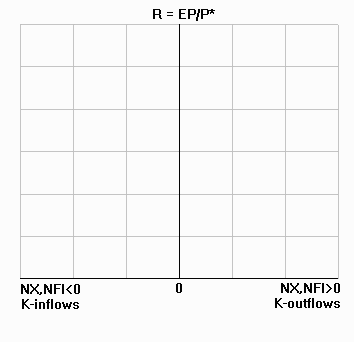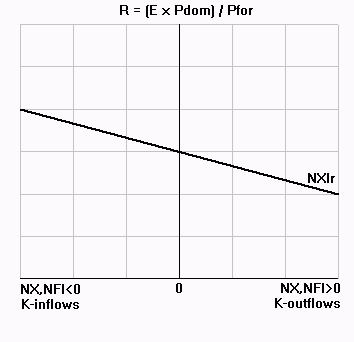D.
Macroeconomic shocks and policies
Key to tracking macroeconomic
events:
focus on interest rates: rdom and
rwld
|
Macro events shift NFI by affecting rdom or
rwld (r*) (1)
Internal shocks affect rdom
(2)
External shocks affect rwld
(r*)
Internal shocks start in the domestic sector and
spill over into the foreign sector.
External shocks originate in the foreign sector and influence the
domestic economy via NX, one of the four key components of the economy's aggregate
demand.
|
 |
1. Internal shocks
Focuses on internal workings of the economy
(1) business cycles
(2) stabilization policies by the government
Context: how macroeconomic stabilization works in an
open economy
SR deviations from the LR equilibrium
The SR matters because nearly everything interesting
about macroeconomic stabilization policies (trying to maintain Yf and stable prices)
concerns SR deviations from a LR equilibrium.
Without a SR there would be no business cycles--we would just move
directly from one full-employment equilibrium to another.
SR exists because of different speeds of adjustment
of key macro variables.
Example 1: If prices rose and fell just as quickly as the money supply,
the real money supply would never change, so there would be no effect at all of monetary
policy (MP)
Example 2: If higher government spending immediately crowded out an
equal amount of other spending, then fiscal policy (FP) would never cause output to
deviate from its full-employment level
But empirically, monetary and fiscal policies do have
real effects, and it is the purpose of macroeconomics to understand them. Those effects
come from differential adjustment rates.
Key to SR effects in open-economy macroeconomics:
Financial assets adjust faster
than goods and services
Our SR focus--the impact
(immediate) effect of
policies
the immediate SR effect as asset markets respond to the policies
Review of macroeconomic policies
Summary of policy effects on Y and r:
| Policy tools: |
Fiscal Policy |
Monetary Policy |
| Expansionary |
hG, iT
g
hY, hr
 |
iRRR,
idiscount rate
buy bonds
g
hY, ir |
| Contractionary |
iG, hT
g
iY, ir
|
hRRR,
hdiscount rate
sell bonds
g
iY, hr |
 |
|
|
One extra complication: Like SR vs LR for a closed economy, we need to consider SR vs LR policy
effects in the foreign sector as well.
Fortunately, means just one more curve to add.
| Short-run
NX: NX Location: LR equilibrium
point
Slope: steeper than NXLR because trade is less
elastic in the SR than in the LR
SR equilibrium above NXLR
=> R>RLR
& r>r*
SR equilibrium below NXLR
=> R<RLR
& r<r* |
 |
| |
|
The LR assumption of fully adjusted output markets
doesn't hold in the SR
Why less elastic in SR?
(1) Passing ER changes on in domestic currency prices takes awhile
Example1: dollar plunged vs. yen in late 1994, but only after several
months did Chrysler lower Jeep prices in yen (by 10%, end of March 1995)
Example2:
dollar fell against the euro by 11.5% in 2007, but european exporters cut costs
rather than raised prices
(2) Executing existing contracts and finding new suppliers take time.
Example: You'll switch to a foreign car, but not until the next time
you buy one..
(3) ER changes prompt entry and exit decisions involving tradable
products, and those take even more time.
Like SRAS v LRAS in macro:
SR shows you where your actual current equilibrium is.
LR shows you where you'll end up eventually
a. Monetary policy (MP)
Example: Expansionary MP
|
Closed: |
ExpMPg
ir g |
hI g
hY |
|
Open: |
|
and
iR which g
hNX g
hY |
| |
 |
|
| ? Which
direction does NFI shift? ?
Impact on R, NX?
(1) SR: +Smoney
--> -rdom
(2) LR: offsetting inflation
--> real Smoney
shifts back |
 |
| |
|
Note: In LR,
price effects will cause this process to reverse =>Monetary policy is neutral in the long run -- true
for both domestic and foreign sector effects
Note2: Real depreciation can make expansionary MP a
beggar-thy-neighbor policy: +NX => -NXfor
A key reason for policy coordination: Group of
8 meets 2x a year for that purpose.
b.
Fiscal policy (FP)
Look at changes in government purchases or taxes. The
analysis works just as well for any other initial spending shock to the economy.
| Closed: |
hG g
|
hY |
|
expansionary effect |
| |
|
&
hr which |
giI |
crowding out of investment |
| Open: |
|
|
&
hR which
g iNX |
crowding out of tradables |
Example: Expansionary FP
(Reaganomics--the twin deficits)
|
|
R |
NX ($billion) |
|
| a |
1980 |
84.9 |
+2.3 |
initial |
| a' |
1985 |
132.5 |
-125.4 |
SR |
| b |
1987 |
90.9 |
-167.1 |
LR: output markets reach LR
elasticities |
| |
|
|
|
|
| ? Which
direction does NFI shift? ?
Impact on R, NX?
|
 |
|
|
|
Recap of
expansionary FP: See FP handout

